You are here
Vietnamese Immigrants in the United States

A woman stands onboard the U.S. Navy vessel on which she was born after her parents had been rescued at sea while fleeing Vietnam in 1979. (Photo: Mass Communication Specialist 2nd Class N. Brett Morton/U.S. Navy)
The arrival of 125,000 Vietnamese refugees to the United States in 1975 was among the most dramatic evacuations undertaken by the U.S. government, matched only recently by the chaotic flights from Afghanistan following the U.S. military’s withdrawal. This initial group of Vietnamese immigrants was followed by more refugees and their families, and the Vietnamese foreign-born population in the United States roughly doubled every decade between 1980 and 2000.
The 1.4 million Vietnamese immigrants now in the country represent one of the largest foreign-born groups in the United States and account for about 3 percent of the overall 44.5 million U.S. immigrants as of 2019. The Vietnamese immigrant population is the fourth largest Asian immigrant group in the United States after those from India, China (including Hong Kong), and the Philippines.
Vietnamese arriving after the mid-1970s were comparatively less educated and had fewer skills, due in part to rampant poverty, strict government control, and severe food shortages linked to trade embargoes and agricultural failures under the new socialist regime, all of which prompted more people to emigrate. Then, following market reforms and the re-establishment of relations between Vietnam and the United States in the 1990s, the number of Vietnamese immigrants began to decline.
The past two decades have seen slower growth of the Vietnamese immigrant population in the United States. The 26 percent growth rate between 2000 and 2010 fell to 12 percent between 2010 and 2019. Unlike previous refugees, most of these newer immigrants came to be reunited with family members already living in the United States.
Figure 1. Vietnamese Immigrant Population in the United States, 1980–2019
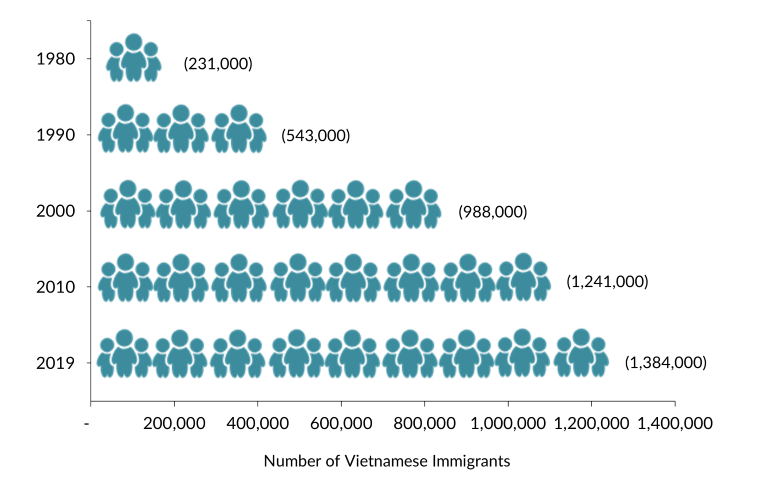
Sources: Data from U.S. Census Bureau 2010 and 2019 American Community Surveys (ACS), and Campbell J. Gibson and Kay Jung, “Historical Census Statistics on the Foreign-born Population of the United States: 1850-2000” (Working Paper no. 81, U.S. Census Bureau, Washington, DC, February 2006), available online.
The United States is by far the most popular destination for Vietnamese living abroad, according to mid-2020 estimates from the United Nations Population Division. Japan is home to the next largest population of Vietnamese immigrants (336,000), followed by China (303,000), Australia (270,000), and Canada (182,000).
Click here to view an interactive map showing where migrants from Vietnam and other countries have settled worldwide.
Within the United States, 52 percent of all Vietnamese immigrants live in either California or Texas. They are more likely than other U.S. immigrant groups to have limited English proficiency, have lower levels of education, and work in service occupations. They also tend to have higher incomes, are less likely to be in poverty, and more likely to be insured.
Using data from the U.S. Census Bureau (the most recent 2019 American Community Survey [ACS] as well as pooled 2015-19 ACS data), the Department of Homeland Security’s Yearbook of Immigration Statistics, and the World Bank, this Spotlight provides information on the Vietnamese immigrant population in the United States, focusing on its size, geographic distribution, and socioeconomic characteristics.
Definitions
The U.S. Census Bureau defines the foreign born as individuals who had no U.S. citizenship at birth. The foreign-born population includes naturalized citizens, lawful permanent residents, refugees and asylees, legal nonimmigrants (including those on student, work, or other temporary visas), and persons residing in the country without authorization.
The terms “foreign born” and “immigrant” are used interchangeably and refer to those who were born in another country and later emigrated to the United States.
Data collection constraints do not permit inclusion of those who gained Vietnamese citizenship via naturalization and later moved to the United States.
Click on the bullet points below for more information:
- Distribution by State and Key Cities
- English Proficiency
- Age, Education, and Employment
- Income and Poverty
- Immigration Pathways and Naturalization
- Unauthorized Immigrant Population
- Health Coverage
- Diaspora
- Remittances
Distribution by State and Key Cities
In the 2015-19 period, Vietnamese immigrants lived in areas with large foreign-born populations. Thirty-nine percent resided in California, with 13 percent in Texas, and 4 percent apiece in Washington State and Florida. The top three counties for Vietnamese immigrants were in California—Orange, Santa Clara, and Los Angeles Counties—followed by Harris County, Texas. Together, these four counties were home to 31 percent of Vietnamese immigrants in the United States.
Figure 2. Top States of Residence for Vietnamese Immigrants in the United States, 2015–19
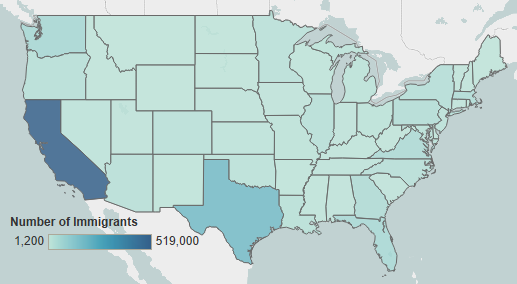
Note: Pooled 2015-19 ACS data were used to get statistically valid estimates at the state level for smaller-population geographies. Not shown are the populations in Alaska and Hawaii; for details, visit the Migration Policy Institute (MPI) Migration Data Hub for an interactive map showing geographic distribution of immigrants by state and county, available online.
Source: MPI tabulation of data from U.S. Census Bureau pooled 2015-19 ACS.
The U.S. cities with the largest number of Vietnamese immigrants were the greater Los Angeles (18 percent), San Jose (8 percent), and Houston (7 percent) metropolitan areas. One-third of all Vietnamese immigrants resided in these three metro areas.
Figure 3. Top Metropolitan Areas of Residence for Vietnamese Immigrants in the United States, 2015–19
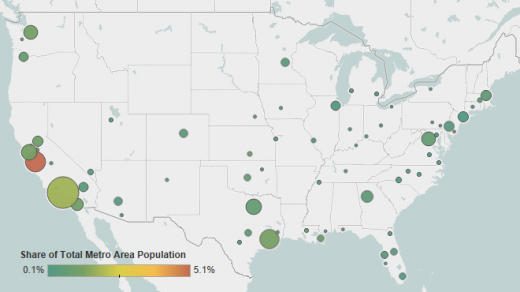
Note: Pooled 2015-19 ACS data were used to get statistically valid estimates at the metropolitan statistical-area level for smaller-population geographies.
Source: MPI tabulation of data from U.S. Census Bureau pooled 2015-19 ACS.
Click here to view an interactive map showing the share of immigrants from Vietnam and other countries in U.S. metropolitan areas.
Table 1. Top Concentrations of Vietnamese Immigrants by U.S. Metropolitan Area, 2015–19
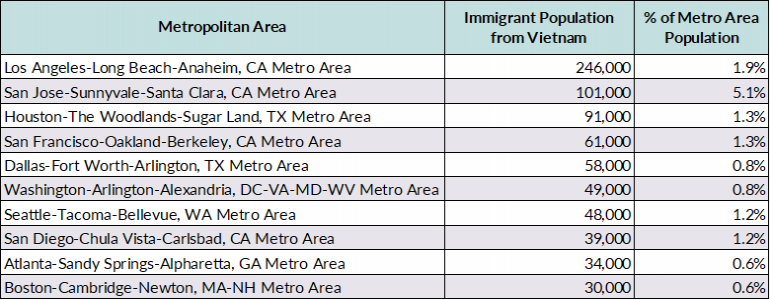
Source: MPI tabulation of data from the U.S. Census Bureau pooled 2015-19 ACS.
Vietnamese immigrants are more likely to be Limited English Proficient (LEP) compared to the overall foreign-born population. In 2019, 65 percent of Vietnamese immigrants ages 5 and over reported limited English proficiency, compared with 46 percent of all immigrants. Just 8 percent of Vietnamese immigrants reported speaking only English at home, versus 16 percent of all immigrants.
Note: Limited English proficiency refers to those who indicated on the ACS questionnaire that they spoke English less than “very well.”
Age, Education, and Employment
The age distribution of Vietnamese immigrants is similar to that of the total foreign-born population: 4 percent were under age 18, 76 percent were between 18 and 64, and 20 percent were ages 65 and older. Both groups were older than the U.S. born. The median age for Vietnamese immigrants was 51 years old, for all immigrants it was 46 years old, and for the U.S. born it was 37 years old.
Figure 4. Age Distribution of the U.S. Population by Origin, 2019
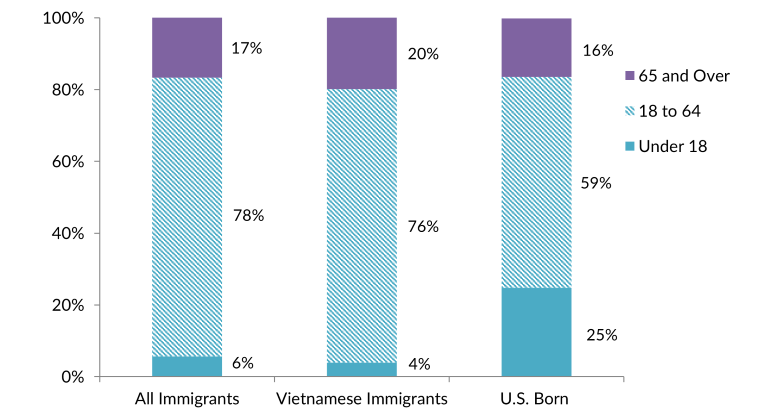
Source: MPI tabulation of data from the U.S. Census Bureau 2019 ACS.
In 2019, approximately 29 percent of Vietnamese immigrants ages 25 and older lacked a high school diploma or equivalent, compared to 26 percent of all foreign-born and 8 percent of U.S.-born adults. Twenty-seven percent of Vietnamese adults had a bachelor’s degree or higher, versus 33 percent of both immigrant and U.S.-born adults.
Vietnamese immigrant adults (ages 16 and older) participated in the civilian labor force at the same rate as all immigrants (67 percent) versus 62 percent of the U.S.-born adults. Vietnamese immigrants were most employed in service occupations (33 percent) as well as in the management, business, science, and arts occupations (32 percent). They were less likely to work in natural resources, construction, and maintenance occupations (5 percent) compared to U.S.-born workers (8 percent) and immigrant workers overall (13 percent).
Figure 5. Employed Workers in the U.S. Civilian Labor Force (ages 16 and older) by Occupation and Origin, 2019
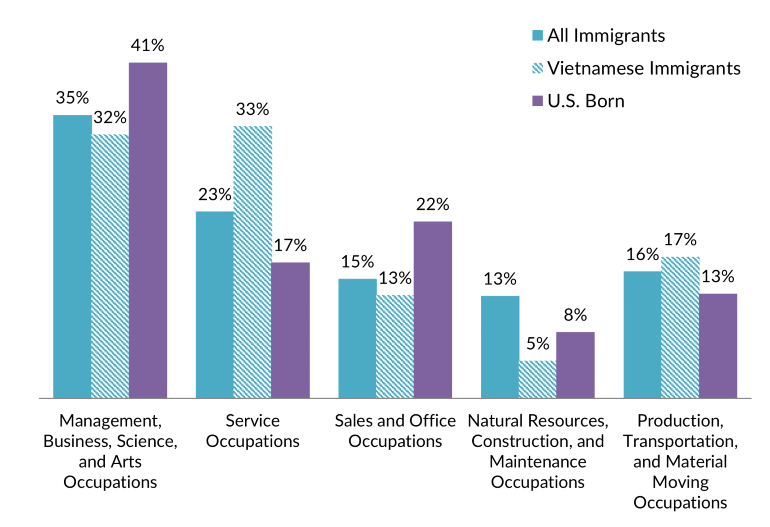
Source: MPI tabulation of data from the U.S. Census Bureau 2019 ACS.
Vietnamese immigrants have comparatively high median household incomes. In 2019, Vietnamese immigrants reported a median household income of $70,000, while the total foreign-born and native populations had median household incomes of $64,000 and $66,000, respectively.
Furthermore, 11 percent of Vietnamese immigrants in 2019 lived in poverty, compared to 14 percent of all immigrants and 12 percent of the U.S. born.
Immigration Pathways and Naturalization
Immigrants from Vietnam are significantly more likely than the overall foreign-born population to be naturalized U.S. citizens. As of 2019, 76 percent of Vietnamese immigrants were U.S. citizens, compared to 52 percent of the total foreign-born population.
Vietnamese immigrants tended to arrive in the United States earlier than other foreign-born groups, with 62 percent entering before 2000, 19 percent entering between 2000 and 2009, and another 19 percent entering in 2010 or later.
Figure 6. Vietnamese and All Immigrants in the United States by Period of Arrival, 2019

Source: MPI tabulation of data from the U.S. Census Bureau 2019 ACS.
The overwhelming majority (95 percent) of Vietnamese immigrants who became lawful permanent residents (LPRs)—also known as green-card holders—in fiscal year (FY) 2019 did so through familial ties as spouses, children, or parents of U.S. citizens, or through other family-sponsored preferences. This compares to 69 percent for all immigrants. Vietnamese immigrants alone made up approximately 3 percent of all new green-card holders receiving their status through immediate U.S.-citizen relatives, and 11 percent of those who obtained green cards via other family-sponsored channels in 2019.
Figure 7. Immigration Pathways of Vietnamese and All Lawful Permanent Residents in the United States, FY 2019
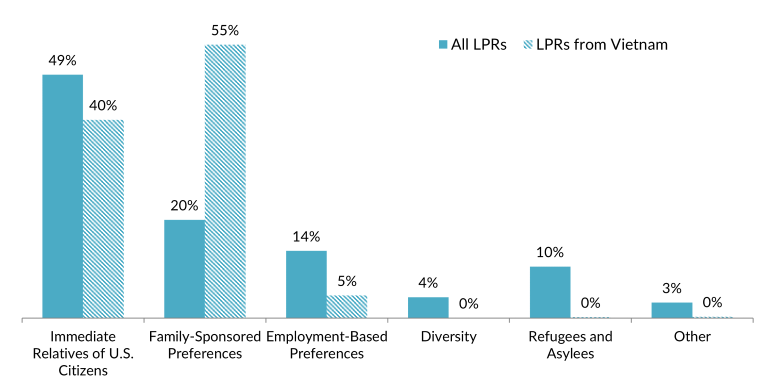
Notes: Immediate relatives of U.S. citizens includes spouses, minor children, and parents of U.S. citizens; Family-sponsored preferences includes adult children and siblings of U.S. citizens as well as spouses and children of green-card holders. The Diversity Visa lottery program was established by the Immigration Act of 1990 to allow entry to immigrants from countries with low rates of immigration to the United States. The law states that 55,000 diversity visas in total are made available each fiscal year. Individuals born in Vietnam are not eligible for the Diversity Visa 2022 lottery.
Source: MPI tabulation of data from Department of Homeland Security (DHS), 2019 Yearbook of Immigration Statistics (Washington, DC: DHS Office of Immigration Statistics, 2020), available online.
The use of family ties to receive LPR status has been greater in recent decades. Until FY 1998, Vietnamese immigrants were more likely to obtain green cards as refugees or asylum seekers. In FY 1982, 99 percent of Vietnamese immigrants who received green cards had entered on humanitarian grounds; in FY 2019, less than 1 percent received LPR status through this channel.
Figure 8. Vietnamese Refugee Arrivals to the United States and Select Immigration Pathways of Legal Permanent Residents, FY 1975-2019
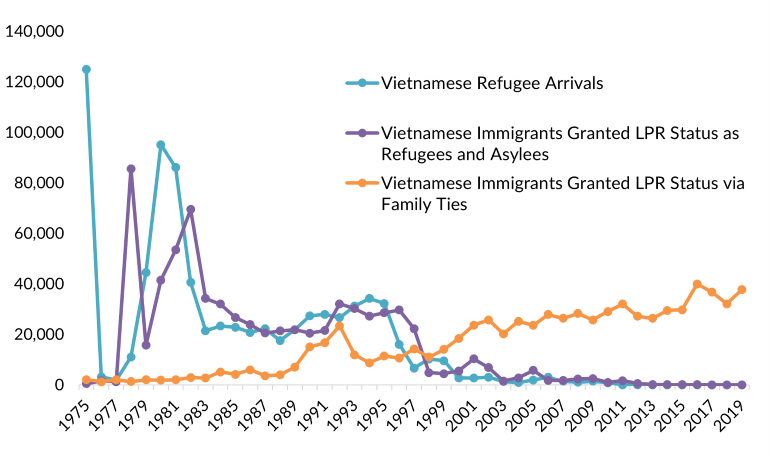
Notes: Family ties refers to receipt of lawful permanent resident (LPR) status both through family-sponsored preferences and as immediate relatives of U.S. citizens.
Sources: MPI tabulation of data from Linda W. Gordon, “Southeast Asian Refugee Migration to the United States,” Center for Migration Studies special issues 5, no. 3 (1987): 153-73; Gail P. Kelly, “Coping with America: Refugees from Vietnam, Cambodia, and Laos in the 1970s and 1980s,” Annals of the American Academy of Political and Social Science 487, no. 1 (1996): 138-49; Rubén G. Rumbaut, “A Legacy of War: Refugees from Vietnam, Laos, and Cambodia,” in Origins and Destinies: Immigration, Race, and Ethnicity in America, eds. Silvia Pedraza and Rubén G. Rumbaut (Belmont, CA: Wadsworth, 1996), available online; U.S. Department of Homeland Security (DHS), 2019 and 2002 Yearbook of Immigration Statistics (Washington, DC: DHS Office of Immigration Statistics), available online; U.S. Immigration and Naturalization Service (INS), Statistical Yearbook of the Immigration and Naturalization Service (Washington, DC: U.S. Government Printing Office, various years); INS, Annual Reports (Washington, DC: U.S. Government Printing Office, 1977, 1976, and 1975).
Unauthorized Immigrant Population
The Migration Policy Institute (MPI) estimates that 58,000 unauthorized immigrants from Vietnam resided in the United States as of 2018, accounting for about 1 percent of all 11 million unauthorized immigrants in the country. Click here for an interactive map of the 2018 unauthorized immigrant population in the United States.
As of June 30, 2021, just 50 Vietnamese immigrants were covered under the Deferred Action for Childhood Arrivals (DACA) program, representing a very small share of the nearly 590,100 active DACA recipients.
Click here to view the top origin countries of DACA recipients and their U.S. states of residence.
Vietnamese immigrants were significantly less likely to be uninsured than the total foreign-born population (8 percent versus 20 percent). They were roughly twice as likely to have private health insurance (63 percent) than public coverage (36 percent).
Figure 9. Health Coverage for Vietnamese Immigrants, All Immigrants, and the U.S. Born, 2019
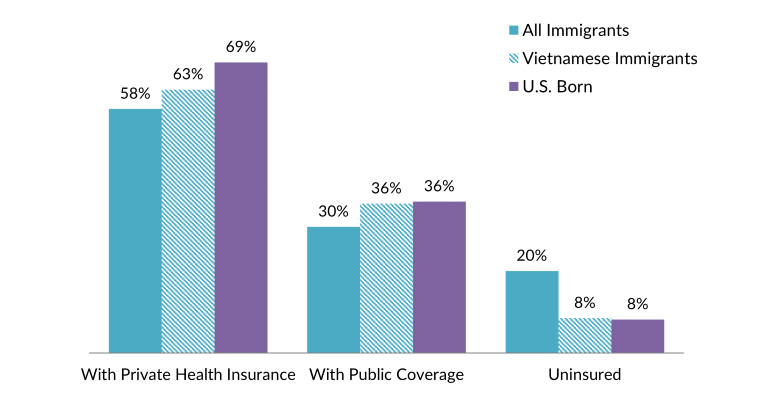
Note: The sum of shares by type of insurance is likely to be greater than 100 because people may have more than one type of insurance.
Source: MPI tabulation of data from the U.S. Census Bureau 2019 ACS.
The Vietnamese diaspora is the 19th largest in the United States and is comprised of approximately 2.3 million U.S. residents who were either born in Vietnam or reported Vietnamese ancestry or origin.
Click here to see estimates of the top 20 diasporas groups in the United States in 2019.
Global remittances to Vietnam have more than doubled in the past decade, reaching $17.2 billion as of 2020, according to World Bank estimates. Remittances represented about 5 percent of Vietnam’s gross domestic product (GDP) in 2020.
Figure 10. Annual Remittance Flows to Vietnam, 2008-20

Source: World Bank Prospects Group, “Annual Remittances Data,” May 2021 update, available online.
Sources
Gibson, Campbell J. and Kay Jung. 2006. Historical Census Statistics on the Foreign-Born Population of the United States: 1850-2000. Working Paper no. 81, U.S. Census Bureau, Washington, DC, February 2006. Available online.
Gordon, Linda W. 1987. Southeast Asian Refugee Migration to the United States. Center for Migration Studies special issues 5 (3): 153-73.
Kelly, Gail P. 1986. Coping with America: Refugees from Vietnam, Cambodia, and Laos in the 1970s and 1980s. Annals of the American Academy of Political and Social Science 487 (1): 138-49.
Kula, Stacy M. and Susan J. Paik. 2016. A Historical Analysis of Southeast Asian Refugee Communities: Post-War Acculturation and Education in the U.S. Journal of Southeast Asian American Education and Advancement 11 (1): 1. Available online.
Kula, Stacy M., Vinh Q. Tran, Iraise Garcia, Erika Saito, and Susan J. Paik. 2021. Vietnamese Americans: History, Education, and Societal Context. Journal of Southeast Asian American Education and Advancement (16) 1: 14. Available online.
Miller, Karl. 2015. From Humanitarian to Economic: The Changing Face of Vietnamese Migration. Migration Information Source, April 2015. Available online.
Rumbaut, Rubén G. 1996. A Legacy of War: Refugees from Vietnam, Laos, and Cambodia. In Origins and Destinies: Immigration, Race, and Ethnicity in America, eds. Silvia Pedraza and Rubén G. Rumbaut. Belmont, CA: Wadsworth. Available online.
---. 2008. The Coming of the Second Generation: Immigration and Ethnic Mobility in Southern California. The Annals of the American Academy of Political and Social Science 620 (1): 196-236.
United Nations Population Division. 2020. International Migrant Stock 2020: Destination and Origin. Available online.
U.S. Census Bureau. 2020. 2019 American Community Survey. Accessed from Steven Ruggles, Katie Genadek, Ronald Goeken, Josiah Grover, and Matthew Sobek. Integrated Public Use Microdata Series: Version 11.0 [dataset]. Minneapolis: University of Minnesota. Available online.
---. N.d. 2019 American Community Survey—Advanced Search. Accessed September 8, 2021. Available online.
U.S. Citizenship and Immigration Services (USCIS). 2021. Count of Active DACA Recipients by Month of Current DACA Expiration as of June 30, 2021. Available online.
U.S. Department of Homeland Security (DHS), Office of Immigration Statistics. 2020. 2019 Yearbook of Immigration Statistics. Washington, DC: DHS Office of Immigration Statistics. Available online.
World Bank Prospects Group. 2021. Annual Remittances Data, May 2021 update. Available online.


